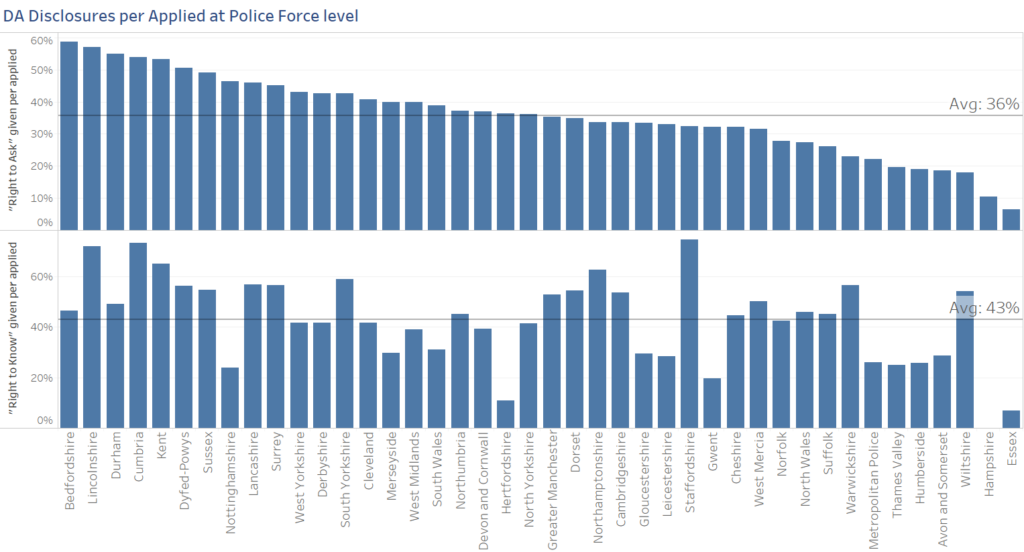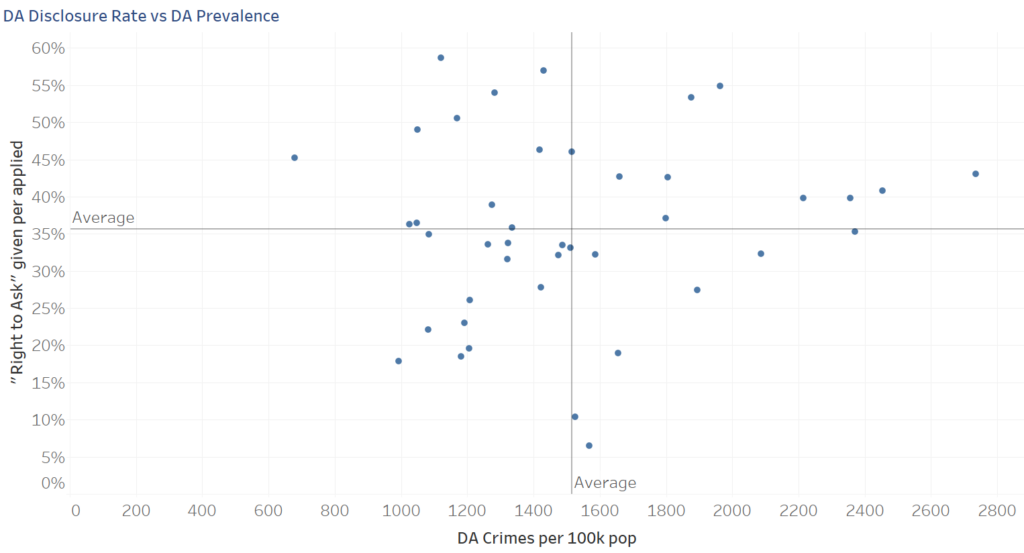;)
Clare’s Law disclosure rates have appeared in the news this month. Published statistics have been used to claim that police forces in England and Wales are leaving people at risk by rejecting Clare’s Law checks on suspected abusers. This blog examines the evidence and suggests actions that police services could take to exploit the legislation to its full effect.
The main findings from this analysis are:
- There is considerable variance between police services in Clare’s Law disclosure rates.
- This variance is not correlated to the prevalence of Domestic Abuse, i.e. there are several forces with low disclosure rates and high prevalence of domestic abuse, and vice versa.
- Local differences in how Clare’s Law has been implemented are contributing to this variance.
Process Evolution can help police services to ensure that they optimise their implementation of Clare’s Law.
Background
The Domestic Violence Disclosure Scheme (DVDS) is more commonly referred to as “Clare’s Law” after the case of Clare Wood, who was murdered in 2009 by her former partner in Greater Manchester. It has been applied by police services since its roll out in 2013. Clare’s Law enables the police to disclose information where it could protect a member of the public who may be at risk of harm from domestic abuse.
The DVDS uses two procedures:
- The “Right to Ask”. Triggered by a member of the public applying to the police for a disclosure.
- The “Right to Know”. Triggered by the police making a proactive decision to disclose information to protect a potential victim(s).
These procedures should be underpinned by risk assessments and practical safety advice when a disclosure is made.
This article poses the following questions:
- Is there variance in the Clare’s Law disclosure rates between police services?
- Is there variance in the rate at which Clare’s Law is triggered between police services?
Data Sources
To inform this blog, we analysed the data tables accompanying the Office of National Statistics (ONS) article titled ‘Domestic abuse and the criminal justice system, England and Wales: November 2023’.
We also reference knowledge gained through demand management work undertaken with the public protection functions of several UK police services.
Analysis
The first chart has two parts. The top half shows the disclosure rate per application under ‘Right to Ask’ (Y-axis) by Service (X-axis), and the lower half under ‘Right to Know’.

Figure 1: Domestic abuse disclosures made against the numbers applied by Police Service
From figure 1 above, we can see the following:
- ‘Right to Ask’ disclosure rates per application vary from 59% down to 6%.
- ‘Right to Know’ disclosure rates vary from 73% down to 0%.
- Those services with high ‘Right to Ask’ disclosure rates don’t necessarily have high ‘Right to Know’ disclosure rates, although Essex is low in both cases whilst Lincolnshire is high in both cases.
The second chart is a scatter plot showing the number of domestic abuse incidents and crimes per 100,000 population against the ‘Right to Ask’ disclosure rate:

Figure 2: Domestic abuse disclosure rates against domestic abuse prevalence within the populous
From figure 2, we can see the following:
- Domestic abuse crimes per 100,000 population (X-axis), range from 378 in Surrey to 2,734 in West Yorkshire.
- There is little correlation between Clare’s Law disclosure rates under Right to Ask (Y-axis) and DA crimes per 100,000 of population.
There are services with a high prevalence of domestic abuse and low Clare’s Law disclosure rates, vice versa and between.
Conclusion
Clare’s Law (DVDS) was designed to reduce domestic abuse by sharing information about a person’s known history. The variances shown suggests that Clare’s Law is not being fully exploited by all services. In our experience, such variances can be caused by many factors, including:
- Lack of awareness amongst the public leading to lower disclosure requests.
- Inefficient processes / different implementations causing delay and additional work, contributing to a lack of capacity to process applications.
Should serious crimes occur when applications under Clare’s Law could have prevented them, reputational damage to police services are the likely result, not to mention the personal harm caused. This is therefore an opportunity worth tackling for the benefit of both the victims and police services.
What can be done?
A process improvement programme, such as that delivered by Process Evolution for vetting processes as part of the Uplift programme, would help realise the benefits from Clare’s Law. Our new cloud-based modelling technology would enable this to be delivered in a more streamlined way.
For more insights and updates, stay connected with our ongoing conversations at www.processevolution.co.uk or reach out to us via email at info@processevolution.co.uk
Written by Peter Loader – Company Founder